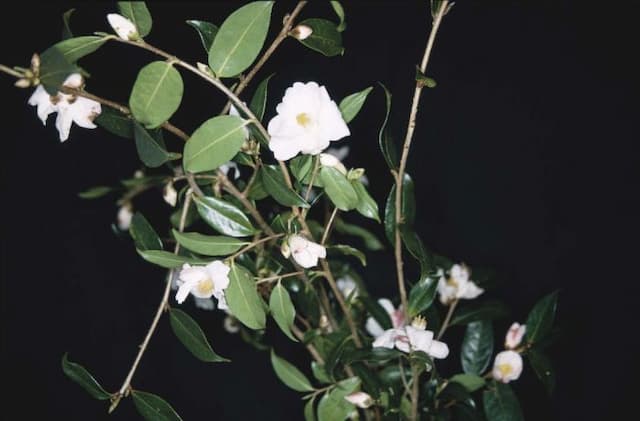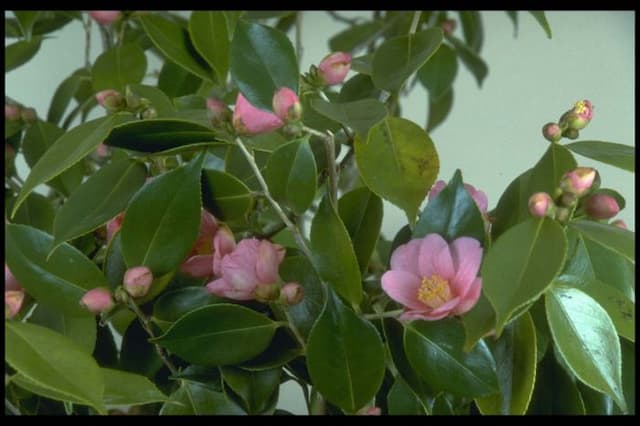Sasanqua Camellia Camellia sasanqua 'Hugh Evans'

ABOUT
The Camellia sasanqua 'Hugh Evans' is an attractive flowering shrub known for its beautiful and ornamental qualities. It features glossy, dark green leaves that provide a lush backdrop to its striking flowers. The flowers themselves are a captivating feature, typically a deep pink hue, which stands out against the foliage. They have a classic camellia appearance, with several layers of petals that open up to create a full, rounded bloom. These petals may display a slight ruffling at the edges, adding to the flower's charm. The blooms are notable for not only their color and form but also for exuding a pleasant fragrance that can subtly perfume the surrounding air. As the plant progresses through its blooming season, the spent flowers often fall away cleanly, keeping the plant looking tidy without much need for deadheading. Overall, the Camellia sasanqua 'Hugh Evans' presents itself as a vibrant, evergreen shrub that adds a pop of color and elegance to the landscape.
About this plant
 Names
NamesFamily
Theaceae
Synonyms
Sasanqua Camellia, Christmas Camellia, Winter Camellia
Common names
Camellia sasanqua 'Hugh Evans'.
 Characteristics
CharacteristicsLife cycle
Perennials
Foliage type
Evergreen
Color of leaves
Green
Flower color
Pink
Height
4-6 feet (1.2-1.8 meters)
Spread
5-7 feet (1.5-2.1 meters)
Plant type
Shrub
Hardiness zones
7-9
Native area
Japan
Benefits
 General Benefits
General Benefits- Ornamental Value: Sasanqua camellia is admired for its beautiful, delicate flowers that bloom in various shades of pink and white, adding aesthetic appeal to gardens.
- Extended Blooming Season: Sasanqua camellia typically flowers from autumn to winter, providing color and interest during a time when many other plants are dormant.
- Drought Tolerance: Once established, this plant has good drought tolerance, making it suitable for gardens in regions with periodic water shortages.
- Evergreen Foliage: Sasanqua camellia keeps its leaves year-round, offering continuous greenery and structure in the landscape.
- Wildlife Attraction: The flowers attract pollinators such as bees, while the dense foliage can provide shelter for birds and other small wildlife.
- Versatility in Landscaping: It can be used in a variety of ways in the garden, including as a hedge, screen, specimen plant, or container plant.
- Shade Tolerance: This plant can thrive in partial shade, making it a good option for underplanting or in spots that don't receive full sunlight.
- Disease and Pest Resistance: Sasanqua camellia is relatively resistant to pests and diseases that commonly affect other garden plants.
- Low Maintenance: Requiring minimal pruning and care once established, it's a good choice for gardeners seeking low-maintenance landscaping options.
- Erosion Control: The dense growth habit and extensive root system can help stabilize soil, reducing erosion on sloped areas.
 Medical Properties
Medical Properties- This plant is not used for medical purposes.
 Air-purifying Qualities
Air-purifying QualitiesThis plant is not specifically known for air purifying qualities.
 Other Uses
Other Uses- As a natural fabric dye: The petals of Camellia sasanqua 'Hugh Evans' can be used to create delicate pink hues on fabrics such as silk and cotton.
- For crafting eco-friendly candles: The wax from camellia seeds can be used to make non-toxic candles, providing a natural alternative to paraffin-based products.
- As part of bonsai cultivation: Due to its aesthetic appeal and ability to be pruned, this camellia variety can be shaped and grown as bonsai, which is a traditional Japanese art.
- In woodworking: The wood of Camellia sasanqua 'Hugh Evans' is hard and can be used for making small wooden objects or inlays in fine furniture.
- For artistic botanical prints: The leaves and flowers of the plant can be used in the art of botanical printmaking, transferring their shapes and colors onto paper or fabric.
- In culinary decoration: The vibrant flowers can serve as edible garnishes for a sophisticated presentation on desserts or entrée dishes.
- As natural confetti: Dried petals of the camellia can be an eco-friendly alternative to synthetic confetti at celebrations and weddings.
- In floral art and ikebana: The elegant form of Camellia sasanqua 'Hugh Evans' makes it a prime choice for traditional Japanese floral arrangements known as ikebana.
- As an organic mulch: Fallen leaves and petals can be collected and used to mulch garden beds, providing an aesthetic and functional soil cover.
- In companion planting: Camellia sasanqua 'Hugh Evans' can be planted alongside other plants that require similar soil and light conditions, creating a beneficial environment for all involved species.
Interesting Facts
 Feng Shui
Feng ShuiThe Camellia is not used in Feng Shui practice.
 Zodiac Sign Compitability
Zodiac Sign CompitabilityThe Camellia is not used in astrology practice.
 Plant Symbolism
Plant Symbolism- Adoration: The camellia flower is often associated with deep reverence and admiration, which can be attributed to its elegant form and lush petals, conveying messages of unspoken and enduring love.
- Devotion: People might gift camellias to express their steadfast dedication to a loved one, signifying loyalty and an unbreakable bond.
- Perfection and Excellence: The lush beauty and perfect form of camellias symbolize ideals of perfection and the striving for excellence, making them popular gifts for performers and artists.
- Longevity: Camellias are known for their long blooming season and resilient nature, symbolizing long life and enduring energy.
- Affection: The camellia's pleasing appearance and delicate scent often represent affection, and gifting a bouquet may indicate warm feelings towards the recipient.
 Water
WaterThe Sasanqua Camellia 'Hugh Evans' prefers to be watered regularly to keep the soil consistently moist, but not saturated. A good approach is to water deeply once a week, providing about 1-1.5 gallons for each watering, depending on the size of the plant and the weather conditions. During the hot, dry summer months, you may need to increase the frequency to twice per week. However, in the cooler seasons or if the plant is in a shadier location, reduce the amount to avoid waterlogging. Always check the soil moisture a few inches deep; if it's dry, it's time to water.
 Light
LightThe Sasanqua Camellia 'Hugh Evans' thrives in partial shade to filtered sunlight. The best spot for this plant would be an area that receives morning sun and afternoon shade, as too much direct sunlight can burn the delicate leaves. Avoid deep shade, as this can lead to sparse flowering. Dappled sunlight from a canopy of trees is ideal for balanced growth.
 Temperature
TemperatureSasanqua Camellias, including 'Hugh Evans', prefer moderate temperatures and do well in USDA hardiness zones 7 to 9. They can survive minimum temperatures down to about 10 degrees Fahrenheit but are happiest in a range of 60 to 80 degrees Fahrenheit. It's important to protect them from harsh winter winds and extreme heat during the summer months.
 Pruning
PruningPrune the Sasanqua Camellia 'Hugh Evans' to maintain its shape, remove dead or diseased wood, and promote more vigorous growth and flowering. The best time to prune is immediately after the blooming season ends, usually in late winter or early spring before new growth begins. Thinning the inner branches can improve air circulation, which is beneficial for the health of the plant.
 Cleaning
CleaningAs needed
 Soil
SoilSasanqua camellia thrives best in well-drained, acidic soil with a pH between 5.5 and 6.5. A mix of 1/3 pine bark, 1/3 garden soil, and 1/3 peat moss is ideal to provide good aeration and moisture retention.
 Repotting
RepottingSasanqua camellias should generally be repotted every 2-3 years in the spring, although mature plants can be repotted less frequently as their growth rate slows.
 Humidity & Misting
Humidity & MistingSasanqua camellias prefer moderate to high humidity levels, ideally around 50-60%, as this helps prevent bud drop and encourages healthy foliage.
 Suitable locations
Suitable locationsIndoor
For indoor growth, ensure bright, indirect light and cool temperatures.
Outdoor
Plant in partial shade, shelter from strong winds, mulch well.
Hardiness zone
7-9 USDA
 Life cycle
Life cycleCamellia sasanqua 'Hugh Evans', commonly known as Sasanqua Camellia, begins its life cycle with seed germination, though cultivated varieties are more often propagated through cuttings to maintain true characteristics. The young plant develops a taproot and foliage, entering a vegetative stage where it focuses on leaf growth and establishing a strong root system. As it matures, typically within 2-3 years, the camellia enters a flowering stage, usually in the fall to early winter, producing fragrant, delicate pink flowers that attract pollinators. After pollination, the plant forms seeds, which are encased in a dry capsule that splits open when mature, although in cultivation, seed production may be limited. Throughout its life, the Sasanqua Camellia undergoes cycles of growth and dormancy, typically experiencing a brief rest period after flowering before new growth begins in the spring. With proper care, including partial shade, well-draining soil, and adequate moisture, it can live for many years, even several decades.
 Propogation
PropogationPropogation time
Early Spring
The Camellia sasanqua 'Hugh Evans', commonly known as Sasanqua camellia, can be propagated most effectively through semi-hardwood cuttings. This method is best undertaken in late summer to early fall when the current year's growth has begun to mature but is not fully hardened. You start by selecting healthy, semi-hardwood stems of about 4 to 6 inches (approximately 10 to 15 centimeters) long. Make a clean cut just below a leaf node and remove the lower leaves to expose a portion of the stem. Before planting, it's beneficial to dip the cut end into a rooting hormone to encourage root development. Then, the cutting is placed in a well-drained potting mix within a container, ensuring that the leaf nodes where the leaves were removed are beneath the surface of the soil. The container should be kept in a warm, bright environment out of direct sunlight, and the soil must remain moist but not waterlogged as the cutting begins to root over several weeks.









